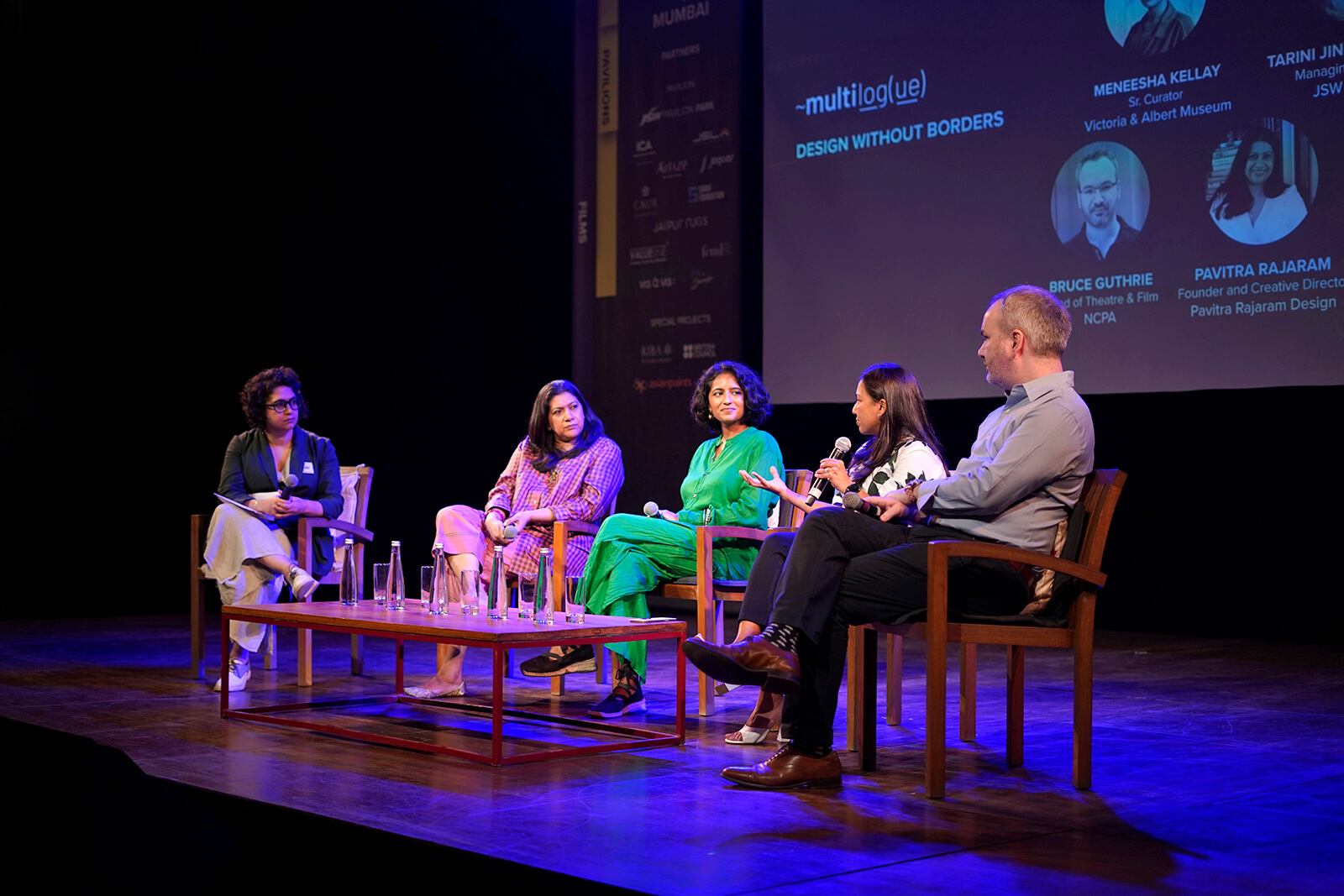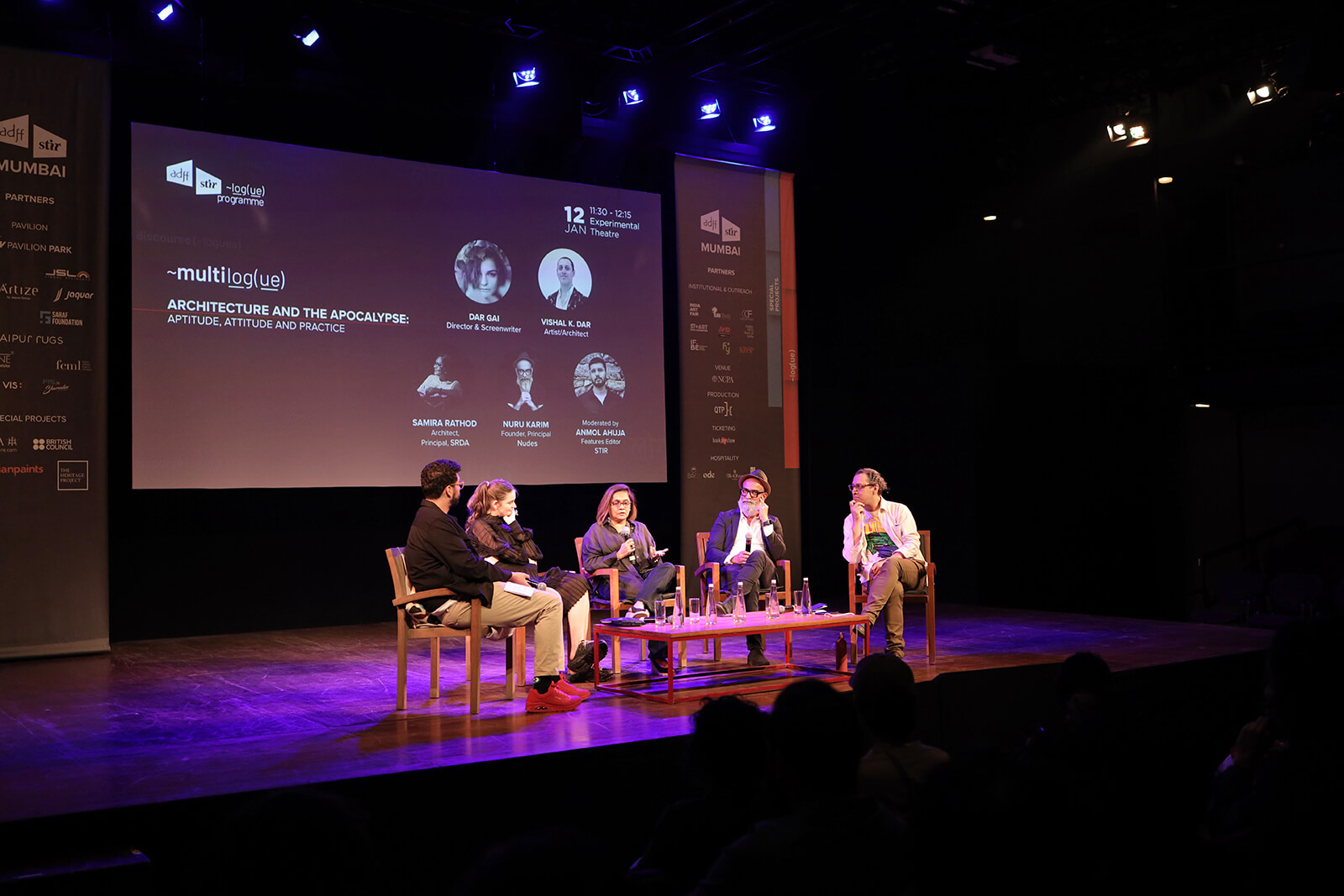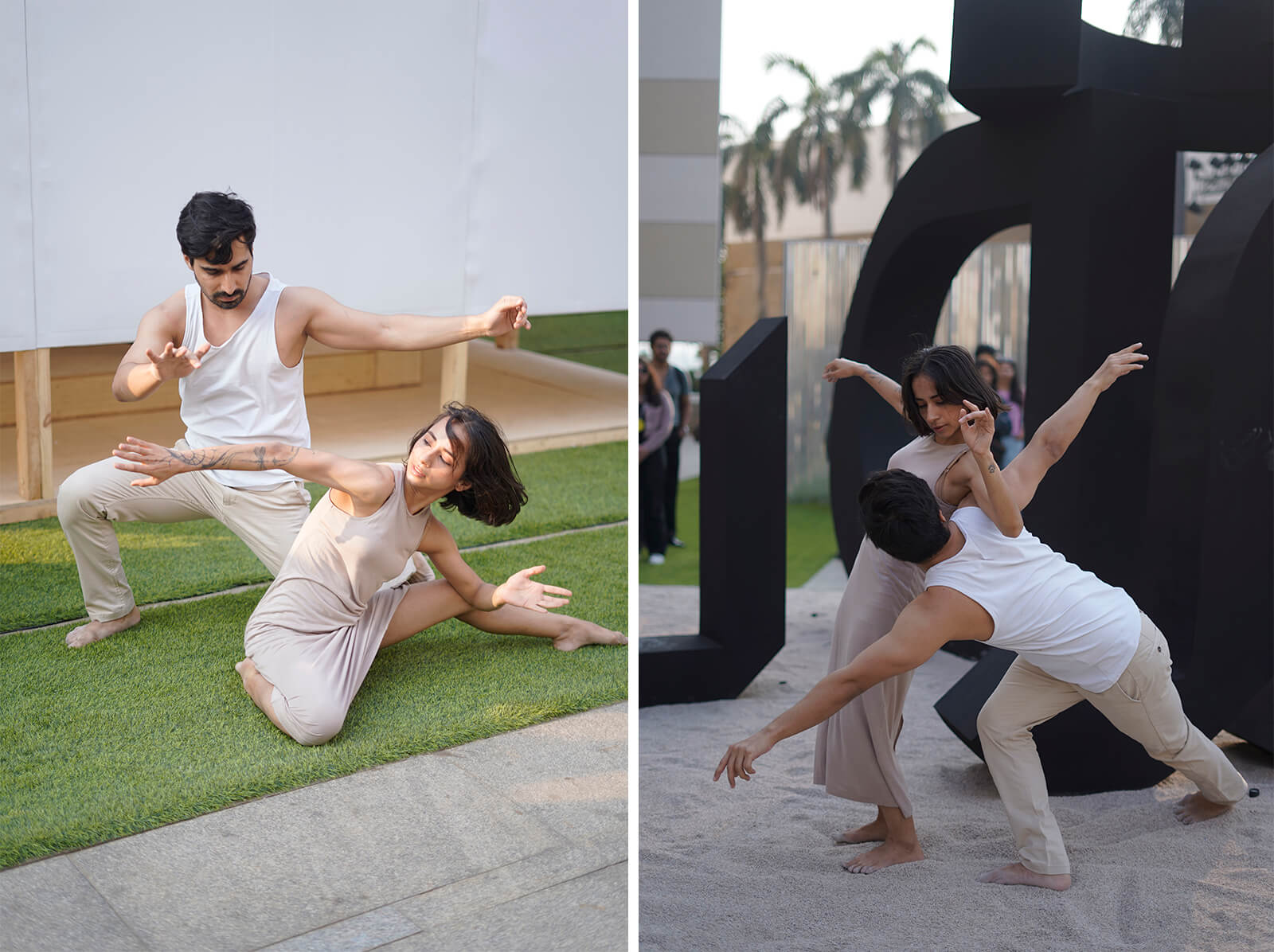ADFF:STIR Mumbai’s ~log(ue) to expand the scope of discourse via disparate mediums
by Almas SadiqueJan 07, 2025
•make your fridays matter with a well-read weekend
by Anmol Ahuja, Anushka SharmaPublished on : Jan 17, 2025
A bright winter sun, a vivacious sea breeze, countless scurrying footsteps—some curious, some eager and others, purposeful—and an all-round enveloping creative spirit; such was the scene at the recently concluded ADFF:STIR Mumbai 2025. The new year, perhaps a dated memory by now, brought in new tidings for us at STIR by way of the fruition of an idea, the seed of which germinated months ago. The idea—that of pushing discourse in the right directions and sparking conversations by, for and of the people—quintessentially telling stories the STIR way, bore for us a familiar fundamental core but a new chassis. We saw some of our foundational principles not only morph into new forms but acquire altogether new lenses through which to be seen, deliberated and practised. In presenting a showcase as unprecedented as ADFF:STIR Mumbai for the first time on home ground, we knew that the novelty in lenses had to be supplemented by a novelty in the festival’s proliferation beyond usual means.
Away from the language of trade shows often dotting the country’s creative landscape and cultural programming—especially within the realms of architecture and design—the proposition of a film festival anchored on these mediums offered the chance at a truly inclusive, dynamic and intersectional space; a platform that could become a canvas for new stories, plural perspectives and an astute examination of the politics of it all. ADFF:STIR Mumbai was, in many ways, an expansion of that genesis, but one that catalysed as well as bolstered this alternative exploration between creative media. What the weekend of January 10-12 bore witness to in the country's financial capital was then a testament to the wider public's readiness to chart the next for the region's creative landscape, and demolish the echo chambers our professions often find themselves operating in.
The 20+ screenings of internationally-acclaimed, festival-darling, globe-travelling and even homegrown films were the beating heart of ADFF:STIR Mumbai, finding a befitting, natural habitat at the festival, being showcased across the venue’s three theatres. Contaminations were rife in the film programming too, with most films, as Kyle Bergman would state, telling a very “human story” of design and architecture. While films on local heroes B V Doshi and Geoffrey Bawa (The Promise: Architect B.V. Doshi and The Genius of the Place: The Life and Work of Geoffrey Bawa) were undoubtedly well-attended and received, it was heartening to see near-full houses for films like Biocentrics (2024), Soviet Bus Stops (2023), The House: 6 Points of Departure (2024) and This Is Not A House (2023) in a special double bill, E.1027 - Eileen Gray and the House by the Sea (2024), Green Over Gray: Emilio Ambasz (2004), Fashion Reimagined (2022) and a classic in the circuit, My Architect: A Son's Journey (2003), screened in a special 4K restored version as part of its 20th anniversary.
The ~log(ue) programme’s most immediate conception stemmed from the stellar films on display, as preceding them or succeeding them in direct conversation with the subject matter of the film, tying in artists, subject experts, industry stalwarts and other impassioned crusaders to the programme. The screening of E.1027, for instance, was enriched by an epilogue from architect Shimul Javeri Kadri, providing deeper context and reflection on contemporary challenges in practice and the resounding urgency of Gray’s story in the face of Le Corbusier’s obsession. Both screenings of Green Over Gray were accompanied by a soulful performance from Aashna Gupta presenting one of her original musical compositions, Choke, complete with an interpretative visual aid. In a personal recounting followed by present lament over the loss of Kahn’s architectural heritage, the film’s director and Louis Kahn’s son, Nathaniel Kahn joined architect Brinda Somaya virtually, captivating the house with both anecdotes and rhetoric.
On an otherwise culturally packed weekend for Mumbai, the rally of oncoming footsteps for the entirety of the festival and packed houses for both our late night and morning screenings emerged as early indicators of its success. The JSW Pavilion Park particularly lent itself to multifarious and tangible methods of engagement that kept visitors exploring, occupying and resting in the rather unconventional spatial caveats the pavilions created. Spread across the venue’s Open Air Plaza and Experimental Garden, the pavilions in the JSW Pavilion Park, responding to the curatorial brief: Frames of Reference, used structural dynamism and a spectrum of visual textures to invite attendees to not just explore but also gauge these cinematic pavilions in more pedagogical ways, prompting reflections on space and its occupation.
Walk of Frames by Manish Gulati of M:OFA and production designer Shruti Gupte, supported by ICA Pidilite, compiled a series of five standalone facades as doorway(s) to transition into the Pavilion Park. Rounding out an expansive field of view ahead were Conserve by LOCO Design in collaboration with CAUR embodying ‘waste made beautiful’; Dialogue by Tania and Sandeep Khosla supported by vis à vis India, comprising the ‘Curry Display’ typeface framed by black serpentine volumes perched weightily on sand; Un-Wrap by Matharoo Associates, with the support of Artize by Jaquar Group, re-interpreting the Klein bottle with a signature pivoting doorway; and Ananta by SHROFFLEóN, supported by Jindal Stainless, flipping a Baoli (stepwell) on its axis to contrive a space of endless reflections using stainless steel.
Other pavilions delved into more real-time activation than sculptural edification, including a particular crowd-favourite—Jaquar’s Powering Passion by reD Architects—combining cycling with a word puzzle inspired by the Indian Constitution’s Preamble; along with UHA’s Stack, a glowing theatre-within-a-theatre supported by the Saraf Foundation, housing artefacts essential to ‘Bombay-living’ under eponymous towering stacks. The pavilion screened documentaries reflecting the cultural significance of Mumbai by Virtual Bharat, Dinesh Choudhary, Sneha Patil, Kutuhala Films, Martin Edström, Saraf Foundation, Sudarshan Sawant, Dhanesh Gopal, Panjaj Rishi Kumar and The Heritage Project. Particularly expansive in geographical approach and outlook was a screening of Saraf Foundation's film, Sagarmatha Next Director's Cut, by Nundrisha Wakhloo. Across the Experimental Theatre’s garden, There is No Planet B, designed by SPASM Design Architects (led by Sangeeta Merchant and Sanjeev Panjabi) and supported by Jaipur Rugs and FCML, reimagined the ancient Indian Chaitya through bamboo scaffoldings and strands of jute fabric, forming a natural sanctum.
Two indoor installations completed the Pavilion Park, revealing their cinematic visions within the NCPA building. Supported by Valueline and FTS by Sharmilee, The Five Virtues by Supraja Rao in collaboration with Shabnam Gupta, Quirk Studio, Apoorva Shroff, Swanzal Kak Kapoor and Kanchan Puri, reinterpreted the enduring virtues of the Pandavas through a feminist design lens. Upstairs, the iridescent installation Tidal Tango by Vibhor Sogani mimicked the ebb and flow of the ocean waves and the cinematic allure of their rhythm and repetition.
To know more about the JSW Pavilion Park at ADFF:STIR Mumbai 2025, read our detailed coverage or visit the Pavilions Section on the ADFF:STIR website.

The STIR-curated ~log(ue) programme’s ambitious and innovative exploration of creative pursuits with critical and interdisciplinary insights on design, architecture and culture were special capstones in the festival. Through unique formats— ~monolog(ue), ~dialog(ue), ~multilog(ue), ~analog(ue) and ~metalog(ue)—a host of talks and performative deliveries sparked stimulating discourses across a range of topics from urban development and the role of communities in reclaiming cities, to the global nuances of design and resistance through arts.
The opening session for the festival’s public days, Cultural Renaissance: Reimagining the City Through Design and Creative Tourism at the Jamshed Bhabha Theatre brought together Martino Stierli, Philip Johnson Chief Curator of Architecture and Design, MoMA NYC; Radha Goenka, Director, RPG Foundation; and Amit Gupta, Founder & Editor-in-Chief, STIR, moderated by Asad Lalljee, SVP, Essar Group and CEO of Avid Learning setting the tone for the festival. A performative ~monolog(ue), Screening the Future: A Tussle Between Memory and Imagination, by storyteller, poet and director, Danish Husain; a contemplative ~multilog(ue), Architecture and Cinema: The Extraordinary Everyday and the Cinemato-Architectural Artefact, with screenwriter and director Megha Ramaswamy, Sameep Padora, Principal, sP+a and Dean, CEPT University and Kyle Bergman, Director of ADFF, moderated by Bhawna Jaimini; along with a ~dialog(ue) titled Culture of/as Care: Nurturing Humanity and the Planet through Trends, Transitions, and Traditions between visual chronicler Gaurav Ogale and casting director Tess Joseph highlighted the expansive talks programming on the first day of the festival.
The second day of the programme offered viewers a dive into Sustainable Fashion: Reality versus Rhetoric, a ~multilog(ue) moderated by Kamna Malik with panellists Sanjay Garg from Raw Mango and Mevin Murden, Director of Education, Istituto Marangoni School of Fashion and Design Mumbai. Artist and photographer Rohit Chawla with Creative Director Swati Bhattacharya contemplated art, change and protest in their ~dialog(ue) Art Activism: Ruse, Respite or Resilience?. Dr. Cleo Roberts-Komireddi, Consulting Editor - Arts, STIR, moderated an impactful ~dialog(ue)—Making a Montage: Impossible Places—at the JB Theatre with panellists Martino Stierli and artist and photographer Dayanita Singh, dissecting the nuances and layers of architectural photography through the speakers’ oeuvres.
The final day of the programme delved into some critical and politically charged conversations. Occupy! Making Space of/for/by the Subaltern, moderated by Ranjana Dave, brought together influential voices such as Poornima Sukumar and Karnika Bai of the Aravani Art Project; Siddhesh Gautam, an artist, writer and Ambedkarite; Priya Dali, Creative Director, Gaysi Family; and Sudheer Rajbhar, Founder, Chamar Studio, to delve into the politics of placemaking through distinctive creative practices in this ~multilog(ue). Design Without Borders, moderated by Samta Nadeem, Curatorial Director, STIR, with panellists Tarini Jindal Handa, Founder, æquō gallery; Meneesha Kellay, Sr. Curator, Contemporary, Victoria & Albert Museum; Pavitra Rajaram, founder and creative director of Pavitra Rajaram Design and Bruce Guthrie, Head of Theatre & Film, NCPA, sought to examine global influences on contemporary design ethics and aesthetics. Architecture and the Apocalypse: Aptitude, Attitude and Practice, a ~multilog(ue) between director and screenwriter Dar Gai, artist/architect Vishal K. Dar, architect Samira Rathod of SRDA and Nuru Karim, founder and principal, Nudes, moderated by Anmol Ahuja, Features Editor, STIR, discussed architecture in the face of current humanitarian and environmental crises. The programme concluded with Culture is Ordinary, a ~metalog(ue) on how film, festivals, public art and publishing can help ensure culture is accessible and accessed on a broad scale with filmmaker Hansal Mehta and Amit Gupta, moderated by curator, creative producer and writer, Bakul Patki.

In the JSW Pavilion Park and elsewhere across the venue, ~analog(ue) sessions including a reflective Juhu Reads session inside There is no Planet B, an evocative dance performance that responded to the dynamic pavilion structures and a play of the Aamchi Mumbai card game amplified layers of interaction in dialogue with the rest of the programming.
To know more about the ~log(ue) programme at ADFF:STIR Mumbai 2025, read our detailed coverage or visit the ~log(ue) Section on the ADFF:STIR website.

Proudly defying categorisation even more than the other offerings at the festival, a trio of Special Projects carved their niches in entirely unexpected ways of how audiences would be either attracted to them or would chance upon them, how they would interact with and how they would stay. Dealing with heritage, colour and aftermath in/of architectural photography, the Special Projects were true standouts that, despite stemming from contaminations charging other corners of the festival, broke new ground and sparked new chatting points.
The Architect Has Left the Building, originally commissioned by RIBA in London and supported in Mumbai by the British Council, materialised as a dual-screen film installation by architectural photographer and filmmaker, Jim Stephenson, along with Simon James and Sofia Smith, exploring how architecture is inhabited and transformed once the architect’s work and publicity shots are done. Enhancing the project further, Stephenson and James conducted an ~analog(ue) session, inviting local photographers and filmmakers to craft a remixed film that played on the participants’ interpretation of the site. Chromacosm by New York-based architect Suchi Reddy and Asian Paints celebrated the unveiling of the world's largest paint colour library through an immersive installation adding a third dimension to colour itself. On the other hand, the work carried out by The Heritage Project, an initiative of the RPG Foundation, came alive in a series of panels outside the JB Theatre, showcasing the provision of urban amenities as a testament to art’s soft power in community upliftment.
Over 7500 professionals and enthusiasts, students and patrons, studio groups and families forming a wide spectrum of audiences across the board from around the country and beyond came together to make ADFF:STIR Mumbai a festival in its truest sense. We measure its success in the numerous well-done-handshakes, the pat on the back mid-run between theatres, the resounding claps after every screening, talk or performance, the exchange of smiles between strangers and the testimonials people wrote and spoke; but most of all in seeing a plethora of people dedicating three days from their otherwise frantic lives to keep coming back to the festival each day. We conclude the debut edition with motivation, and a promise to deliver something better the next time around. ADFF:STIR will see you in 2026.
For more information, visit the ADFF:STIR Mumbai website for key highlights of the festival, including the 20+ films, 10 cinematic pavilions, special projects the ~log(ue) programme, media and press coverage and more. Stay tuned and keep an eye out for ADFF:STIR Mumbai 2026.
by Mrinmayee Bhoot Oct 14, 2025
The inaugural edition of the festival in Denmark, curated by Josephine Michau, CEO, CAFx, seeks to explore how the discipline can move away from incessantly extractivist practices.
by Mrinmayee Bhoot Oct 10, 2025
Earmarking the Biennale's culmination, STIR speaks to the team behind this year’s British Pavilion, notably a collaboration with Kenya, seeking to probe contentious colonial legacies.
by Sunena V Maju Oct 09, 2025
Under the artistic direction of Florencia Rodriguez, the sixth edition of the biennial reexamines the role of architecture in turbulent times, as both medium and metaphor.
by Jerry Elengical Oct 08, 2025
An exhibition about a demolished Metabolist icon examines how the relationship between design and lived experience can influence readings of present architectural fragments.
 surprise me!
surprise me!
make your fridays matter
SUBSCRIBEEnter your details to sign in
Don’t have an account?
Sign upOr you can sign in with
a single account for all
STIR platforms
All your bookmarks will be available across all your devices.
Stay STIRred
Already have an account?
Sign inOr you can sign up with
Tap on things that interests you.
Select the Conversation Category you would like to watch
Please enter your details and click submit.
Enter the 6-digit code sent at
Verification link sent to check your inbox or spam folder to complete sign up process



by Anmol Ahuja, Anushka Sharma | Published on : Jan 17, 2025
What do you think?